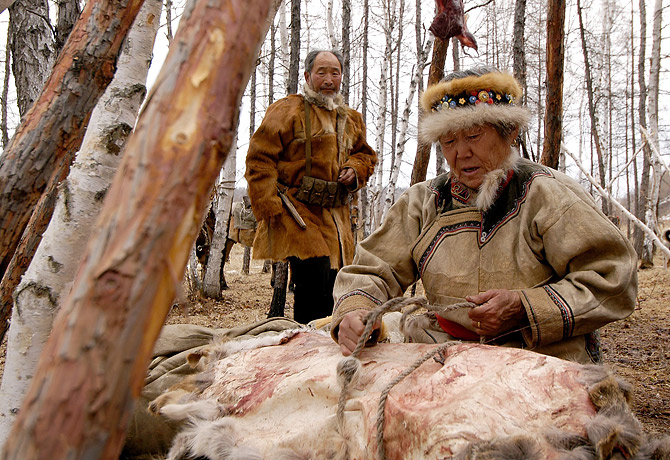 |
|
| The Oroqen's hunting traditions, unchaged for centuries, are disappearing. Timothy O?Rourke / Sinopix |
Hunting is good. It's good for the body," says Baiyaertu, 83, his hazel eyes twinkling as he smokes a cigarette from a long plastic holder. "After you come back with something, you feel really happy." A member of the Oroqen, an ethnic group from China's northeast, he first pursued game in the wilderness as a child with his parents. It has been decades since he last hunted, but his memories are strong.
For most Oroqen, memories of hunting are all they have. As with many of its dozens of other ethnic minorities, China has moved aggressively to assimilate this small group of hunter-gatherers into society. At a time when ethnic unrest in Tibet and Xinjiang threatens to disrupt China's carefully planned Olympic celebrations, Beijing's experience with the Oroqen illustrates the benefits and costs of China's drive to modernity.
For centuries, the group roamed the pine and birch forests of China's Greater and Lesser Xing'an Mountains, living in hide-covered dwellings called sierranju that are nearly identical to the teepees of North American Great Plains tribes. The Oroqen way of life continued largely unchanged until the middle of the past century, even as China rose and fell under war, revolution and invasion. But the modern world began to encroach with a vengeance after the founding of the People's Republic of China in 1949. Two years later, not long after the People's Liberation Army invaded Tibet, Baiyaertu and several other Oroqen leaders negotiated the formation of the Oroqen Autonomous Banner, a type of administrative division that dates back to the Manchu, on a 23,000-sq.-mi. (60,000 sq km) corner of Inner Mongolia near the Russian border. "There were so many of them and so few of us," he says. "What could we do?"
At that time there were just 2,251 Oroqen in China. By the 2000 census, the population had grown to 8,196. For many Oroqen, the end of a hunting lifestyle meant never wondering where their next meal would come from. "Before liberation, Oroqen went to the edge of extinction," reads a plaque at the Oroqen Museum in Alihe, the banner's capital, which credits the Communist Party with helping the tribe make the leap from primitivism to modernity. "Oroqen are marching towards the magnificent future."
Not everyone agrees. The Oroqen's traditions are eroding; their children speak only Mandarin. And they are now a minority in their own land. Immigration to Inner Mongolia has increased the total population of their banner to nearly 300,000, of which 90% are Han Chinese. "In the past, there was no road, no railroad. There were no Han people. There was nobody here," says Baiyaertu. "You could see deer, roe deer, everything. Now there are people here, and the animals have all gone." Faced with a dwindling supply of game, the government outlawed hunting on the Oroqen banner in 1996. While it is permitted for part of the year in adjoining Heilongjiang province and some Oroqen still head to the mountains to poach, hunting is vanishing as a way of life. For a people whose culture is based on the nomadic pursuit of game, the effect has been devastating. "They can't adjust to the rhythm of modern life," says Baiyaertu's son Bai Ying, 46, who works as a painter and cultural researcher in Beijing. "They can't farm, so they drink every day."
The assimilation of the Oroqen has been only somewhat successful, says Hing Chao, chairman of the Orochen Foundation, a Hong Kong--based charity that works to preserve the tribe's traditions. "They are assimilated, yes. But they are not integrated into the mainstream of society." To help the Oroqen cope, Beijing has launched initiatives including free housing, farming assistance and education. It's still possible that the Oroqen's future under China will be magnificent. But by then much of their heritage, like the game they once hunted, will have disappeared into the forests for good.
Global Dispatch For a new postcard from around the world every day, visit time.com







